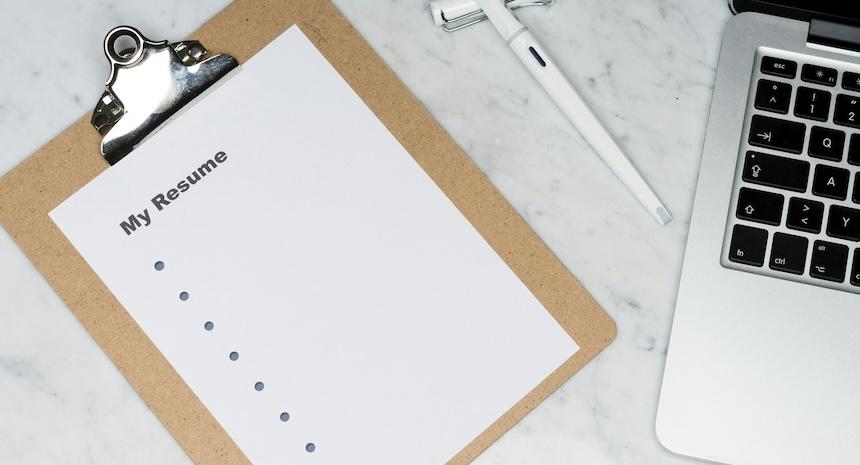Our resume tips and tricks will help you bring your resume to the next level, whether you're building your resume for the first time, updating an out-of-date resume or simply hoping to improve a resume that isn't having the impact you'd hoped for.
Our guide will help you make the most of resume tips from career experts by offering:
- A breakdown of resume tips for formatting your resume.
- Tips to help you make the most of your resume content.
- Resume-building tips to help you go the extra mile and make a resume that stands out.
- Key takeaways to keep in mind as you build or upgrade your resume.
Is getting started your biggest hurdle? Our AI Resume Builder has your back! This tool provides generated text suggestions to get you past that initial writer's block as well as formatting help and professional templates to style your resume for success!
Resume Formatting Tips to Help You Organize Your Resume
A resume is all about first impressions. Hiring managers and recruiters might receive hundreds of applications for a single role. You want to capture the employer's attention and give them the immediate feeling that you're a candidate worth interviewing.
Doing this begins with formatting your resume properly. Here are some good resume tips to keep in mind as you start to format your document.
You don't have to be a graphic designer to submit a resume with a slick style and a clean layout. Choose a premade resume template to save yourself the headache! The best template will be one that matches your role, so use your best judgment. An estate lawyer's resume and a high school art teacher's resume require different approaches.
Tip #2: Match Your Template to Your Role
Here's a tip for writing a resume that feels unique and personable: Pick a creative resume template! If your role is personality-focused and the position you're applying for seems to value unique and expressive candidates, then a creative template is just what the doctor ordered. For a more traditional or conservative role, a sleek modern template is a safe bet.
Tip #3: When in Doubt, Go Back to Basics
Don't let the design of your resume distract you from what matters. The perfect template makes a big difference, but your content should ultimately be the star. If you aren't sure what to do, choose a simple template where the design takes a back seat to your content.
Tip #4: Pick an Appropriate Font
Speaking of getting carried away with design elements, remember that no matter how fun fonts like Papyrus or Comic Sans can be, somebody has to actually read your resume. Stick with a tried-and-true resume font with no fancy flourishes that might confuse an applicant tracking system (ATS). We recommend classics like Arial, Calibri and Times New Roman.
Tip #5: Consistency Is Key
Want to know what makes a resume look clumsy instead of polished? Inconsistency! Choose a font size and stick with it, pick appropriately readable line spacing and stick with it! Set your margins to 1 inch all around and stick with it! Consistency in the little details adds up quickly and makes your resume look professional and well-put together.
Tip #6: Break It Up
Nobody wants to read an endless block of text with no gaps or whitespaces to rest their eyes on. Your resume should use formatting elements to hold the reader's attention and guide them through your experience. Use bullet points for your job history so employers can easily scan through your past roles without getting fatigued or lost.
Tip #7: Make Your Header Count
The header of your resume might not seem important, but it's a critical resume section. This humble little collection of contact information makes it possible for employers to reach out to you for an interview. Isn't that your resume's main goal? Make sure this section is neat, accurate and contains all the contact avenues it should. That way, if your resume does its job, you'll receive the call or email you've been waiting for.
Tip #8: Use a Standard File Type
Some job listings will specify the file type they're expecting. The best resume tip we can give you is to pay attention to the listing and follow instructions. But if there isn't a file type listed, send your resume as either a Word doc or a PDF. These are general standards that should work in most situations.
Tip #9: Check Out Examples From Pros in Your Industry
We can provide you with resume-building tips until the cows come home, but nothing beats a visual example. Check out resume examples from successful candidates, especially professionals from your field, to get some real-world inspiration.
Resume Writing Tips to Help You Build an Impactful Resume
Now that you've got your resume's formatting down, it's time to write a resume that tells your story. This might seem like a tall order, but our resume tips and tricks will help you get started on a resume that captures what you have to offer.
Before you write your content, take a closer look at the listing for the job you're targeting. Your resume should be customized to align with the role you're hoping to land. Incorporate keywords from the job description to show how well you fit the role. This will make you a stronger candidate to humans and to the applicant tracking systems (ATS) that employers use to filter out candidates using these same keywords.
Wondering how well your resume matches the role? Try Resume Now's free AI Resume Review for an in-depth analysis of your resume's content, structure, and role-specific keywords.
Tip #11: Start With a Strong Profile
A resume should begin with a resume profile where you quickly outline what you bring to the table. This section is very important. You never know how long a hiring manager is going to spend reading your resume, so you want to outline your most important information right away. If you're a newcomer to the workforce, a resume objective works well for this because it is goal-oriented rather than experience-focused.
Tip #12: Choose Balanced Skills
Your skills section might seem like the perfect opportunity to load your resume with impressive technical skills — and it is! But it's important to remember balance too. Our best tip for writing a resume skills section is not to underestimate your soft skills. Skills like interpersonal communication, networking, critical thinking and problem-solving are hard to teach and can be even more important on a resume than specific techniques or expertise.
Tip #13: Use Active Language
It's easy for a resume to turn into a laundry list of all the responsibilities you've held over the years. But if your resume is boring you then it'll probably bore employers too! Spice it up with strong action verbs that cast you as an energetic doer and paint a vivid picture of what you're capable of. Think "spearheaded" instead of "started," and "created" instead of "made."
Tip #14: Make It Real With Numbers
A truly impressive resume doesn't just tell what you can do, it shows employers the kind of results they can expect when they hire you. Make employers want to pick up the phone and call you right this second by discussing your experience in terms of measurable outcomes. Use numbers to indicate the impact you've had and demonstrate how well you understand your role and its performance expectations.
The Best Resume Tips to Go the Extra Mile
With the tips for writing a resume that we've covered so far, you have the foundations of a really strong resume in your tool belt, but how do you take your resume to the next level? Here are the best resume tips to elevate your resume from "strong candidate" to "absolute no-brainer."
The traditional resume sections are a great start, but who says you have to stop there? Boost your resume with sections like volunteer work, certifications or languages. These extra sections will make your resume unique and demonstrate your commitment to your skills, values or career trajectory. Just don't sacrifice any of the traditional sections in favor of these. Resume real estate is valuable and extras are just that — extra.
Tip #16: Organize Around Your Strengths
Let's take a quick detour back to the issue of resume formatting. Most of the time, the classic chronological format is the way to go. This format outlines your experience in reverse-chronological order. But what's the best tip for a resume with no experience at all? A first-time resume need not adhere to this format. Instead, a functional format that lets you fill space with skills makes a great alternative. You could also combine the two with a combination resume format, which is great for career transitions.
Tip #17: Include Relevant Links
Do you have a personal website? An active LinkedIn presence? An online portfolio that showcases your work? Link out to any personal websites, portfolios or profiles that are relevant to your career and the role. Getting a look at your work and your professional persona can help give recruiters that extra push to reach out.
Tip #18: Add a Matching Cover Letter
It's impossible to talk about going the extra mile without mentioning cover letters. A great cover letter is the perfect cherry on top of a strong resume. Writing a cover letter gives you a chance to add context to your resume, explain why you're interested in this role in particular and communicate more about why you're the right choice. Our Cover Letter Generator can help you get started on a letter that matches your resume.
Key Takeaways
-
Make Smart Formatting Moves
Your resume's formatting forms the employer's first impression. Choose a style that's appropriate to your industry, consistent and easy to read. From there, you're free to make it as unique and character-filled as you want, so long as it's still industry-appropriate.
-
Write Thoughtful Content
The content of your resume should be unique and customized to suit the exact role you're seeking. Maintain a balance between hard and soft skills while also showing off your impact on past roles using strong active language and measurable outcomes.
-
Go Above and Beyond
Don't let traditional formatting rules or strategies limit you. Build an impressive resume by playing to your strengths, adding extra information if it works in your favor and linking out to other platforms where you can demonstrate your talents. Once you've done all of this, don't forget to write a cover letter too!
Resources to Help With Your Job Search
- Cover Letter Tips to Help Your Letter Stand Out
- How to Update Your Resume in 2025 (Guide + Expert Tips)
- How to Prepare for a Job Interview
- How to Improve Your Resume
- Can a Resume Be Two Pages?
Was this information helpful? Let us know!
Hailey Brophy is an experienced writer with a diverse career in digital publication. She is passionate about using her unique skills and experiences to help job seekers find the information that they need to succeed.
More resources

Career Gridlock: 60% of Workers Feel Trapped in Jobs They Want to Leave
Resume Now s survey reveals a growing trend in workers feelin...

What Is an Elevator Pitch for an Interview? + Examples
Imagine you step into an elevator and right beside you is a h...

Bullet Points on Resume: Examples & Guide for 2025
Bullet points on your resume make your experience and accompli...

Amazon Resume: Examples, Job Description & Tips
Make a resume for an Amazon fulfillment center that matches th...

Top Government Resume Examples & Writing Tips for 2025
Was this information helpful? Let us know &star &star &star &s...

Top Librarian Resume Examples & Writing Tips
Was this information helpful? Let us know &star &star &star &s...
